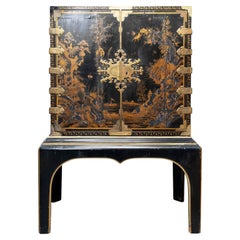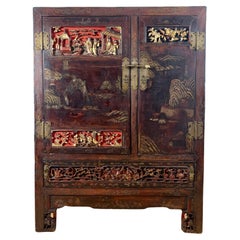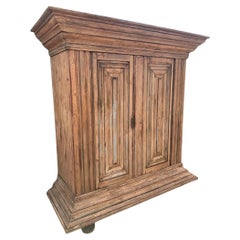Rerere Case Pieces and Storage Cabinets
to
Height
to
Width
to
Depth
to
1
1
1
1
1
1
1
1
1
1
1
1
Early 18th century Japanese Lacquer Cabinet on Stand
Located in Rīga, LV
Rectangular cabinet has nine drawers inside. Hinges, corner mounts and lock plates in gilt brass. Decorated with river landscapes, insects, birds and animals in pairs. The stand is i...
Category
Antique Early 18th Century English George III Cabinets
Materials
Wood, Lacquer
Related Items
18th Century Chinese Lacquered Cabinet - Fujian Province
Located in Hoddesdon, GB
An 18th century Chinese lacquered and intricately carved and hand painted cabinet of small proportions .
A beautiful all over patina and aged surface , the entirety of the cabinet is painstakingly decorated with landscape , coastal scenes , figures , birds , flowers etc the cabinet . The panelled doors to the front , bottom drawer & feet are carved in a deep relief showing various scenes , embellished with red lacquer and gold leaf , retaining its original engraved metal work .
This cabinet originates from the Fujian province...
Category
Antique Mid-18th Century Chinese Cabinets
Materials
Elm
Early 18th Century Swedish Gustavian Cabinet
Located in San Angelo, TX
A stunning and unique baroque early 18th century Swedish Gustavian cabinet that features two doors with shelving inside and sets on ball feet. This piece completely breaks down to he...
Category
Antique Early 18th Century Swedish Gustavian Wardrobes and Armoires
Materials
Wood, Paint
Early 18th Century Baroque Rustic Oak Cabinet on High Stand
Located in Lucenec, SK
This amazing Danish Baroque oak cabinet is made at the beginning 18th century. In the past, the lower drawer was apparently repaired by a folk carver. The cabinet has an original and...
Category
Antique 18th Century Louis XIII Cabinets
Materials
Oak
Early Baroque Cabinet, 18th / 19th Century
Located in Greding, DE
Two-door cabinet with shallow proportions and richly carved, multi-curved crown, adorned with a winged cherub in a cartouche with wavy edges. The cabinet stands on compressed bun fee...
Category
Antique Early 18th Century Baroque Cabinets
Materials
Iron
Early 18th Century Spanish Walnut Cabinet
Located in Gloucestershire, GB
An Extremely Interesting Early 18th Century Spanish Walnut Food Cupboard.
Designs of this sort seem to have been produced from the 16th century onwards but this example dates to the...
Category
Antique Early 18th Century Cabinets
Materials
Walnut
18th Century Queen Anne Lacquer cabinet on stand.
Located in Brighton, Sussex
A beautifully decorated Queen Anne period lacquer cabinet on stand. Having pierced, fretted brass hinges and lock plates. Chinoiserie scenes to the doors, opening to reveal ten fitte...
Category
Antique 18th Century English Cabinets
Materials
Lacquer
Antique Rustic Cabinet, France, Early 18th Century
Located in Antwerp, BE
This exquisite cabinet dates back to the 18th century and hails from France, showcasing exceptional craftsmanship and patina only achievable with age. Its strikingly rustic design fe...
Category
Antique Early 18th Century French Rustic Cabinets
Materials
Wood
Flemish 18th Century Tortoiseshell Inlaid Cabinet on Stand
Located in Los Angeles, CA
A traditional Flemish ebonized wood cabinet, made in Antwerp in the 18th Century, with gorgeous tortoiseshell inlaid, supported on a stand with matching tortoiseshell panels and bun ...
Category
Antique 18th Century Belgian Cabinets
Materials
Tortoise Shell, Mirror, Wood, Ebony
Early 18th Century Japanned Double Corner Cabinet
Located in Lymington, GB
A rare chinoiserie standing double corner cabinet, or cupboard.
English, George I-period, ca 1720.
Often erroneously referred to as lacquer work, this is japanned. Beautifully decorated with idyllic scenes of rockwork, pagodas, people, trees, birds, water, with bridges and a boat.
This is a lovely and very useful addition to a room - where corners can present furnishing dilemmas - and this is a chic antique drinks cabinet. These have always been very hard to find, as opposed to the more usual Georgian hanging corner cupboards...
Category
Antique Early 18th Century English George I Cabinets
Materials
Lacquer
18th c. English Black Lacquer and Parcel Gilt Japanned Corner Cabinet on Stand
By Giles Grendey
Located in Wichita, KS
A fine 18th c. English black lacquer and parcel gilt Japanned corner cabinet on stand, circa 1760. Attributed to Giles Grendey, London; cabinet maker (1693-1780). The cabinet and sta...
Category
Antique 18th Century English George II Cabinets
Materials
Wood, Giltwood, Lacquer, Paint
H 85 in W 39.75 in D 25.63 in
18th Century Black Lacquer Chinese Cabinet
Located in New York, NY
A monumental 18th century black lacquer and cinnabar embellished cabinet. Brass and steel hardware with three drawers at the base. Fitted wide interior shelves.
Category
Antique Late 18th Century Chinese Cabinets
Materials
Wood
An Important Late 17th Century Japanese Lacquered Cabinet Edo Period on Stand
Located in Benington, Herts
An extremely fine, elegant and rare late 17th Century Japanese lacquer cabinet, from the Eco period, on later lacquered black stand.
Japanese circa 1690
Provenance
A private Scottish collection
This outstanding cabinet is a fascinating fusion of east and west. The cabinet itself would have been made in Japan, c.1690, and is decorated to the outside with hiramaki-e lacquer. This technique involves the use of sprinkled gold powder which adheres to the lacquer surface. On the best pieces, as with this example, many layers are added in order to create areas of high relief and give depth to the surface decoration. The taste of the Japanese workshops in this period was often for quite restrained pieces with plenty of the black background visible, unlike some of the busier Chinese lacquer or European japanned examples produced around the same time. The Japanese makers seemed content to rely on the outstanding quality of the lacquer itself, regarded by most experts as the finest lacquer ever produced, and did not see the need to cover every surface believing that less was more in this respect. The lacquer here is used to produce a mountainous scene with buildings on the bank of a river, the other side of the river with more buildings and a contrasting flatter and forested landscape. The fine perspective achieved is the result of the clever use of raised and flatter areas in the lacquer itself in combination with the drawing of the design itself.
Another remarkable aspect of this piece is the fine metalware throughout, but particularly the lockplate / hasp, hinges and foot mounts to the front. This is all beautifully cast and engraved contrasting against the black background. Interestingly another cabinet on stand with near identical metalwork was advertised in the Burlington Magazine, November 1913, with the dealer W. Williamson and Sons of Guildford. The lacquer on that piece is similarly refined and it seems likely that both pieces came from the same workshop.
The European influence in our piece can be seen in both the later ebonised stand and in the japanned decoration which has been applied to the inside of the doors and is also very fine indeed. This consists of two panels with birds of prey perched on branches in colours set against a golden background. The cabinet has a recent Scottish provenance and so it is likely that the ebonised stand was made in Britain though such pieces were made throughout Europe as a way of quite literally elevating these imported pieces of eastern lacquer as in Japan these would have been used on the floor. Inside the cabinet there is a combination of more Japanese lacquer and lock plates and European drawer handles. Most of the lacquer drawer fronts incorporate mountainous scenes and birds in combination, with a few purely one or the other of the two subjects. Again the lacquer is in excellent condition and is of exceptional quality with multiple layers of relief used in one single scene in many cases.
As mentioned above, Japanese lacquer is the most technically brilliant of the eastern lacquers and, as such, was highly prized by collectors and connoisseurs throughout Europe when this piece was made. The acquisition of such pieces would only have been possible for a small group of incredibly wealthy individuals, largely royal or high ranking courtiers or merchants connected with the East India trade...
Category
Antique 1690s Japanese Edo Cabinets
Materials
Lacquer
H 61.82 in W 38.59 in D 22.05 in


